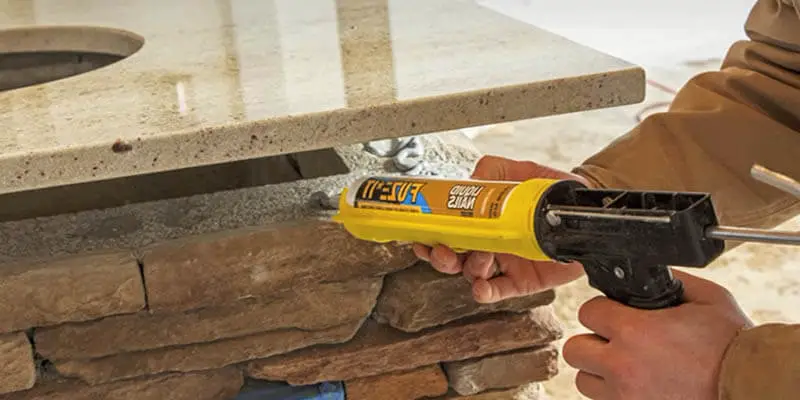Liquid nails are used to seal tile and hard surfaces, and users mainly utilize a caulking gun to apply them. It can be applied in two ways: with or without a caulk gun.
A caulking gun pistol maintains constant pressure on the tube and creates a smooth and equal finish. While you can apply pressure with your hands as well, utilizing a caulking gun eliminates the possibility of causing a mess.
But after reading this article, you’ll learn both how to use liquid nails with and without a caulking gun and how it will help you seal things without the help of a professional.
How to Use Liquid Nails With a Caulking Gun: What are the Steps?
If you’ve ever searched for traditional guidelines for installing tiles, particularly ceramic ones, then there’s a good possibility you’re familiar with construction adhesives.
They were fasters that operated effectively and produced outstanding results for an extended period of time. But what is a good construction adhesive? Liquid nails are the answer.
Liquid nails are extremely precise and capable of sealing various types of materials. As a result, you’re able to do things efficiently and without encountering any dirt. In addition, when the liquid nail dries, it creates exceptional strength.
Usage of Liquid Nails With a Caulking Gun
To apply Liquid Nails or another type of construction glue in a zigzag pattern, press it into position. For usage, construction adhesive is loaded into a caulking gun through a tube. But what is the appropriate process? Here are the steps:
Step 1: Fill Up the Caulk Gun
Load the caulking gun first. To fill up the caulk gun, you must pull the piston away from the frame a little. Then, with your thumb, squeeze the trigger. This will loosen the rod that goes through the frame. Squeeze it back and hold it with your other hand.
Step 2: Apply Pressure to the Tube
A tube of the liquid nail is put into a gun and then placed into its frame to load it. Make sure the tube is in the back, and the nozzle is in front of the fun. Press the button twice so that the piston can touch the surface.
Step 3: Remove the Tube Tip
Next, you’ll need to cut off the tube tip. In every caulk tube, there is an opening way. It should be cut to fit the size of the fracture. Use a razor blade, or the gun may have a pit where you can cut the tip-off.
Step 4: Testing the Gun
In order to be sure that liquid nails will flow in the right direction, you should do a small test first. First, make a mark on a piece of paper by pulling the trigger several times.
Step 5: Press the Caulk Gun
Two hands should be used to hold the caulk gun. Put your hand on the back of the caulk gun and keep your finger on it when you want to apply it. Make sure that you keep your other arm close by so you can put glue where it needs to be.
Step 6: Let the Applying Nail Dry
Once they’re done setting, leave the liquid nails alone to dry. In any condition, the adhesive takes anywhere from 12 to 24 hours to dry.
Usage of Liquid Nails Without a Caulking Gun
In order to use liquid nails, you’ll need a caulking gun. If you don’t have access to a glue gun, you can still use adhesive to form a bond, but this method requires more effort and attention than caulking with a gun. A caulking gun pistol maintains pressure on the tube, resulting in a smoother and equal finishing.
Step 1: Select the Appropriate Liquid Nail
Select a liquid nail that is the same color as the applicant with whom you wish to bond. Cut the tube’s tip at an angle of 3/16″ with a sharp knife.
Step 2: Press the Nail and Apply
Hold the tube in your hand and twist the end to squeeze out the adhesive. Ensure that the liquid nail tube’s tip is aligned with the fissures. Press the tube into the cracks with your hand and let it dry. Balance the pressure so that the liquid cannot create a mess.
Step 3: Wet the Tip of the Nail
Don’t forget to moisten the tip with water to let the glue spread evenly. Then, allow the liquid nail to dry before applying it to the surface.
Best Adhesives to Use Without a Caulking Gun
Even if you aren’t using a gun, you must always cut the nail tip at a 45-degree angle. This is a list of two common adhesives that don’t need to be used with a caulking gun.
1. Latex Caulk
If you don’t have a caulking gun, you can still use latex caulk. This is due to the fact that it can be cleaned with just soap and water. Choose a color that complements the surface you’re caulking or a white shade that can be quickly painted over.
After purchasing the caulk, cut the tip at 45° and test it. After that, you can begin working on your project. First, make sure the tip is at the right angle, curve the tube’s end for a constant caulk, and run the tip slowly over the line.
You should wear a latex glove to protect your finger and dip it in water before smoothing the edges of the latex. But in the case of looking for Unibond sealant without a gun, you should keep in mind that, with a precision nozzle for smoother application and speed control, there is no need for a gun.
So do not be bothered between the caulk squeeze tube vs. gun, do squeeze.
2. Silicone Caulk
Sealants made of silicone can be used in places that get wet, like outside or in bathrooms. Because it is waterproof, it can be used there. Caulk should match the surface it is being applied to as closely as possible in terms of color. For bathroom sealant without a gun is also required silicone caulk.
Related: How To Replace Silicone Around Sink?
While applying this product, curl the tube end to get the greatest finish. If you don’t have a caulking gun, you’ll have a far more difficult time cleaning up a mess with silicone caulk than with other sealants.
Silicone caulk is a good choice if you don’t have a gun for liquid nails.
FAQ
What is the alternative to a homemade caulking gun?
How do you use a caulking gun and liquid nails together?
What can I use Liquid Nails on?
Wrapping Up!
Finally, while a caulking gun is not required, having one will make your application process easier and help you avoid any problems. Hopefully, your confusion about how to use liquid nails without a caulking gun has been solved.
Want to Learn More:
- How To Caulk Door Trim And Jambs – Particular Steps Explained
- Is Landlord Responsible For Caulking (Assumption Or Fact)
- How to Get Rid of Mold in Shower Caulk – Multiple Solution
- 3 Causes Why Does Clear Caulk Turn White?
Hello! this is John Cox. If I’m not wrong, you love Home. Right? And you already met one of them who’ve been in this field since 2005 and still go on. According to my interest, I’ve started this blog to share my thoughts about Home sectors, and you’ll love it.


